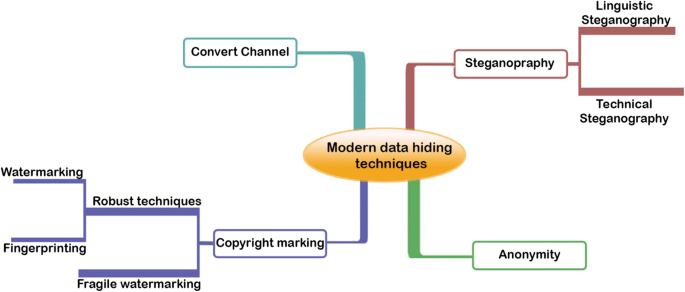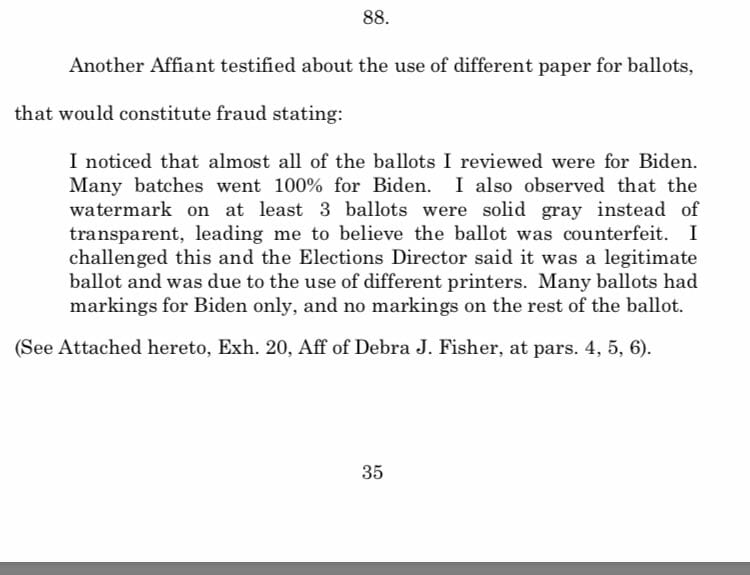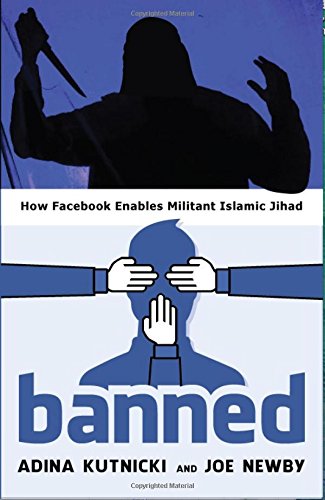
Watermarked Ballots CONFIRMED In Sidney Powell’s Lawsuit! [VIDEOS]
WE LOVE TRUMP | By Noah | November 27, 2020
Ok friends, this is sure to stir up some emotional responses….
We’ve been covering the Watermarked Ballot story since the first week in November.
Some of you see the evidence, others hate it and think it’s just “hopium”.
Below is all the research we’ve uncovered so far and it’s voluminous!
You can just keep scrolling and reading and it will keep you occupied for a couple hours at least!
And I encourage you to really dig in.
But for those of you who are up to speed, I have an update for you.
And this is for those who think there’s absolutely no way the ballots were watermarked.
Just “hopium” huh?
Well, not according to Sidney Powell and the lawsuit she filed in federal court!
Take a look, right here on Page 35:
Well what do you know, the ballot watermark theory ain't just a theory. #kraken https://t.co/IwZTS3uQZc
— Dr Lawrence Sheldon PsyD (@LeisurelyLarry) November 26, 2020
Watermark theory validation on pg 35!@SidneyPowell1 #ReleaseTheKraken pic.twitter.com/ohY1X2yFEp
— The Deplorable One (@FitzyCrisp) November 26, 2020
— Dionysus (@Dionysus_fx) November 26, 2020
Here’s a zoom in on that page:

Ok, so that would be “transparent watermarks”….am I reading that correctly?
Folks, have I not told you all along to keep the faith?
Have I not told you to pay attention to the watermarks?
Oh my….
It’s all coming out now!
Here is more on the watermarks, just released:
Real Ballots Watermarked & Tracked by Quantum Voting System (QVS) https://t.co/wPIGQPkB9N
— Star Nations News℠ (@StarNationsNews) November 19, 2020
Real Ballots Watermarked & Tracked by Quantum Voting System (QVS) https://t.co/wPIGQPkB9N
— Star Nations News℠ (@StarNationsNews) November 19, 2020
Come on folks….
Eventually the “coincidences” just become too much to say it’s just random chance.
So if you’ve been tracking this story, it is generating a LOT of controversy.
Essentially, the theory has been stated that President Trump’s team, in some connection with DHS and CISA, have watermarked the real ballots with a quantum blockchain code or watermark.
Ummmmmm, is this Melania Trump wearing a "blockchain" dress on Election Day?
— DailyTruthReport (@DailyTruthRpt) November 12, 2020
🤔🤔🤔
Just a coincidence, I'm sure……. pic.twitter.com/UxPZakTYqz
Melania Trump wears a block chain patterned dress on Election Day, Nov 3rd, 2020 . . .https://t.co/zAjm80H3Hs via @TheNationalNews
— Daniel Lee (@dnajlion7) November 10, 2020
The National News covered the story but focused on the price of the Gucci dress:
The US first lady, Melania Trump has cast her vote, stopping in at a voting centre in Palm Beach, Florida, close to President Donald Trump’s Mar-a-Lago resort.
From catwalk to first lady: 49 photos that show Melania Trump’s style evolution
Why a recent photo of Donald Trump and the First Lady has reignited the ‘Fake Melania’ conspiracy theory
Melania Trump steals limelight in fluoro ‘green screen’ Valentino dress
Melania sported a $4,500 chain-print Gucci dress while voting in the swing state.
Asked why she didn’t vote with the Republican president last week, the First Lady told reporters on Tuesday: “It’s Election Day so I wanted to come here to vote today for the election.”
The first lady waved and smiled at reporters.
She was the only person not wearing a mask when she entered the Morton and Barbara Mandel Recreation Centre to vote, presumably for her husband.
It’s unclear if she wore a face covering inside the voting centre.
Washington Post CONFIRMS Watermarked Ballots sting OP from a story published this past August! pic.twitter.com/pbPiptAzOM
— Daniel Lee (@dnajlion7) November 9, 2020
Here’s the key part of the article (I’ve highlighted the key word for you):
And here is more of the article in context, from the Washington Post of all places:
An 11- page assessment of mail voting risks released by the Department of Homeland Security’s cybersecurity division outlines dangers including cyberattacks that could undermine mail ballot processing. It also warns of possible delays in tabulating ballots that arrive after Election Day.
It even cautions that U.S. adversaries might use partisan differences over mail voting to undermine faith in the election.But it doesn’t mention fraud once.
That stands in stark contrast to the president, who has repeatedly claimed without evidence that mail voting will lead to widespread fraud. More recently Trump has pared back his attacks by saying mail voting will be done well in Florida and Arizona but is still dangerous elsewhere — seemingly because that is politically advantageous for him.
The document from DHS’s Cybersecurity and Infrastructure Security Agency (CISA) is dramatic evidence of the jarring difference between Trump’s views of mail voting and the assessments of security professionals in his own government.
Trump, for example, has slammed mail voting because late-arriving mail ballots may delay election results. “Must know Election results on the night of the Election, not days, months, or even years later!” he tweeted.
CISA, by contrast, acknowledges there might be delays and says “election officials, media, candidates, and non-governmental organizations are working collaboratively to educate voters and set the expectations that the results on election night will be less comprehensive and it will take days, if not weeks, to determine the outcome of many races.”
A CISA spokesperson told me “CISA assesses a shift to absentee voting or voting by mail does not create a net increase in cybersecurity risk to voting infrastructure but instead moves risk to centralized processing infrastructure and additional third-party support. While this report examines those risks to infrastructure, issues of criminal abuses and fraud are outside the scope of the assessment.”
The document makes no mention of Trump’s attacks on mail voting.
But it does note that “mail-in voting has already become an issue among partisan political voices” and warns that makes it a juicy target for Russia and other U.S. adversaries to exploit with disinformation campaigns.
Specifically, “threat actors may exploit a delay in [election] results to sow discord, manipulate public discourse, and discredit the electoral system, all to undermine the U.S. democratic system,” the assessment notes.
“To mitigate the risk of disinformation, voters should receive accurate information about mail-in voting to increase their understanding of the process along with reminders to rely on authoritative sources such as their state and local election officials when questions arise,” it adds.
CISA’s assessment reflects how many groups are grappling with the possibility of delayed election results – and the opportunity that could create for Trump or someone else to sow doubts.
Facebook CEO Mark Zuckerberg, for example, warned during an employee meeting the social media giant may need to add explanatory labels to posts by media and political figures that claim victory in races where results aren’t final, BuzzFeed’s Craig Silverman and Ryan Mac report.
Zuckerberg didn’t have a plan for Trump declaring victory before there are valid results, BuzzFeed reported.
“This is where we’re in unprecedented territory with the president saying some of the things that he’s saying that I find quite troubling,” Zuckerberg said. “We’re thinking through what policy may be appropriate here. This is obviously going to be a sensitive thing to work through.”The CISA assessment doesn’t deny there are risks to states dramatically increasing mail voting during the pandemic.
But it treats those risks as natural byproducts of any major undertaking, warning that “all forms of voting…bring a variety of cyber and infrastructure risks.”
For each risk, the document also lists “compensating controls” that state and local election officials can implement to make mail voting safer.
It also lists nine different “procedural controls” that should give voters confidence their votes are being tabulated correctly and phony ballots can’t sneak in. Those include verifying voters’ signatures against another signature on record, a privacy envelope preventing anyone from giving different treatment to ballots marked for particular candidates, specialized codes allowing voters to track their ballots, and watermarks linking ballots to particular jurisdictions.
“When implemented properly, mail-in voting has a series of layered safeguards to defend the process from manipulation,” the assessment states.
A surge in mail voting may actually make the election more secure against hacking.
That’s because it probably will reduce the number of people who vote on outdated machines that lack a paper record. Those machines make it impossible for officials to audit votes after the election and ensure they were recorded accurately and not manipulated by hackers.
A TON more here:
Now let’s keep going…
There is a LOT more to go.
The theory of watermarked ballots has proven to be one of the most controversial stories we have ever covered.
And we are continuing to investigate and report on it here at WeLoveTrump.








